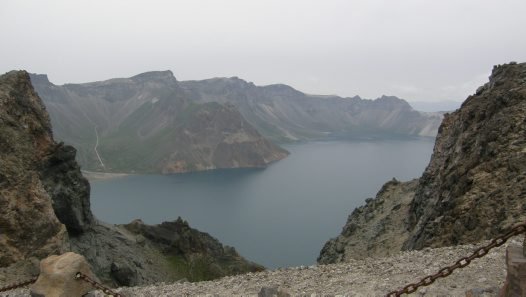Ancient Trade Ignores Modern Political Boundaries
Obsidian artefacts reveal social relations between Russia and China about 20,000 years ago.

Paektusan Volcano, China.
Image: Peter Jia© University of Sydney
Stone tools acquired from three obsidian sources were transported long distances across northeast China and Far East Russia during the late Palaeolithic period. A study of the physical attributes of the artefacts reveals that some were traded between groups and others were carried by hunters moving over large areas in pursuit of seasonal game.
Archaeologists often employ chemical techniques to link stone artefacts back to their geological origin. Our project uses a portable instrument called a PXRF. A PXRF measures the amount of particular elements present in the stones by recording the fluorescence created when x-rays are bounced off their surfaces. The resulting maps showing where material was moved have generally been thought by archaeologists to represent ancient trading patterns. The basic method sounds easy, but two key problems can limit the studies.
Firstly, modern national boundaries frequently prevent scientists working in the region where the artefacts are found from acquiring knowledge about geological sources located in another country. Secondly, it is difficult to distinguish spatial patterns created when ancient people carried tools over large distances as part of their annual seasonal migrations versus those resulting from a series of exchanges among groups living in different areas.
To tackle these problems, our research team brought together archaeologists from Russia and China. By sharing data on the locations and chemical make-up of obsidian sources across the region, we identified artefacts that had been moved from outcrops in both countries across the borders into the other.
Obsidian from the Paektusan source on the border of China and North Korea was the most widely transported, probably because it is very high quality material that would have been sought after for making stone tools. To our great surprise, a few pieces of seemingly much less desireable glass from two sources in Russia, near Tigrovy in the Shokotovo Plateau and at Gladkaya, also made their way to Palaeolithic sites in China. Although it seems a bit like taking ‘coals to Newcastle’, there are good reasons why stone might be transported in opposite directions.
A detailed study of the kinds of tools that were moving revealed that hunters using Paektusan obsidian made special tools that could be repaired easily and they also carried spare parts. In their pursuit of highly mobile game, they needed to ensure that their tools were always ready and in good shape. It is also beneficial for hunters living in small groups to establish good social relations with the few communities that they encounter, because later on assistance in times of hardship could come in handy. To cement these important connections and ensure safe passages, small pieces of obsidian, often from Tigrovy and Gladkaya, were given as gifts or tokens of friendship. These were then passed along to other groups and after many years, they ended up a long way from their source.
Our combination of chemical techniques with archaeological analyses of the physical properties of the artefacts, further enhanced by international collaboration, has provided an exciting new picture of life during the harsh conditions of northeast Asia during the Palaeolithic. In these ancient times modern political boundaries were no obstacle to hunters with well prepared and effective tools barbed with obsidian tips as they ranged over large distances in search of game. People further invested in their safety by giving pieces of the shiny obsidian as gifts to cement friendships and alliances.
Dr. Robin Torrence
Senior Principal Research Scientist
Acknowledgements:
Our research would not have been possible without the tremendous support of our colleagues at The Centre of Frontier Archaeology, Jilin University, China and the Institute of History, Archaeology and Ethnology, Far East Branch of the Russian Academy of Sciences, Vladivostok, Russia. It has been a privilege to experience the long distance social relations first established thousands of years ago by their ancestors.
More information:
Doelman, T., Jia, P., Torrence, R., and Popov, V. 2014. Remains of a puzzle: the distribution of volcanic glass artefacts from sources in Northeast China and Far East Russia. Lithic Technology39(2): 81-95.
Jia, P., Doelman, T., Torrence, R., Glascock, M. 2013. New Pieces: The Acquisition and Distribution of Volcanic Glass Sources in Northeast China during the Holocene. Journal of Archaeological Science 40: 971-982.

















